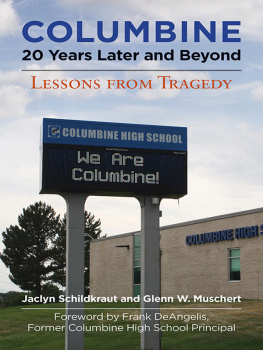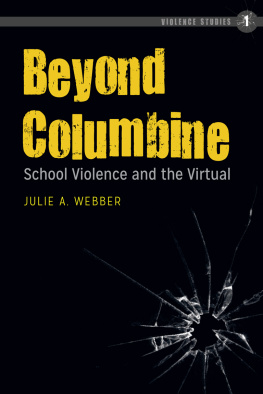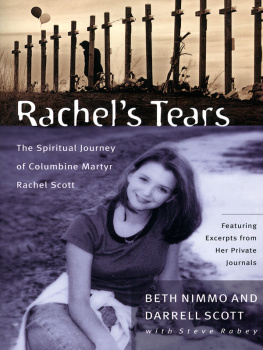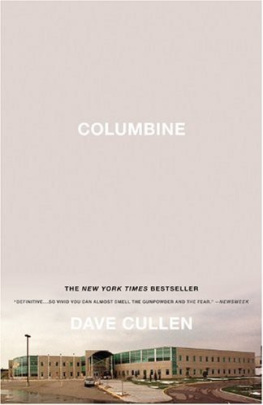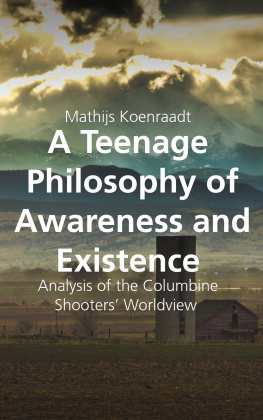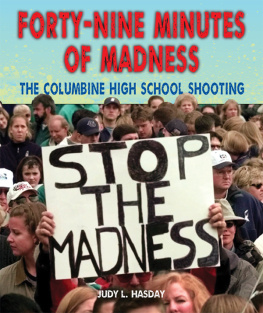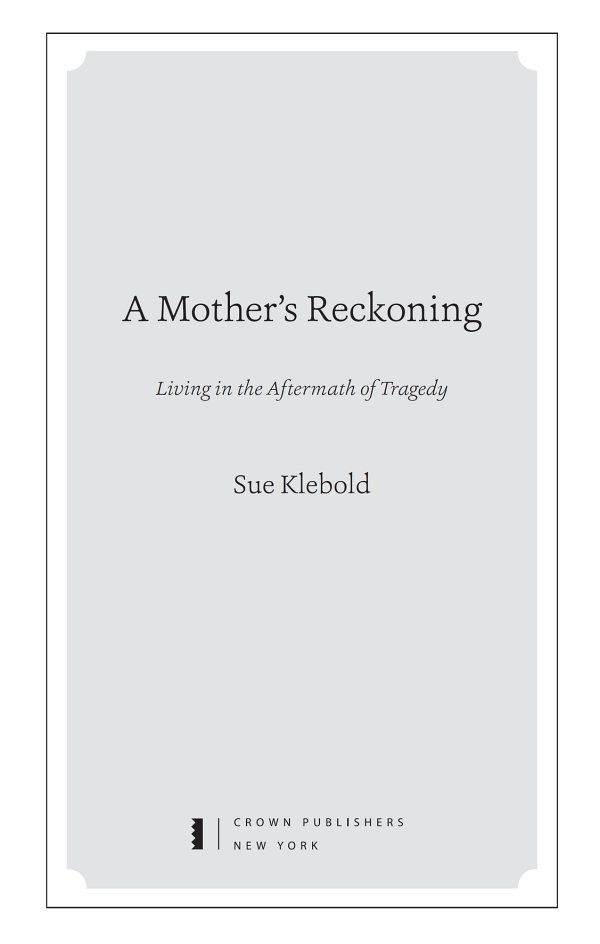Copyright 2016 by Vention Resources Inc., PBC
Introduction copyright 2016 by Andrew Solomon
All rights reserved.
Published in the United States by Crown Publishers, an imprint of the Crown Publishing Group, a division of Penguin Random House LLC, New York.
www.crownpublishing.com
CROWN is a registered trademark and the Crown colophon is a trademark of Penguin Random House LLC.
Grateful acknowledgment is made to The Permissions Company, Inc., for permission to reprint an excerpt from And must I then, indeed, Pain, live with you from Collected Poems. Copyright 1954, 1982 by Norma Millay Ellis. Reprinted by permission of The Permissions Company, Inc., on behalf of Holly Peppe, Literary Executor, The Edna St. Vincent Millay Society, www.millay.org.
Library of Congress Cataloging-in-Publication Data
Klebold, Sue.
A mothers reckoning : living in the aftermath of tragedy / Sue Klebold.First edition.
pages cm
1. Columbine High School Massacre, Littleton, Colo., 1999. 2. School shootingsColoradoLittleton. 3. Columbine High School (Littleton, Colo.) 4. Klebold, Sue. 5. Klebold, Dylan, 19811999. 6. MothersColoradoLittletonBiography. I. Title.
LB3013.33.C6K55 2016
373.0978882dc23
2015018513
ISBN9781101902752
eBook ISBN9781101902769
International edition ISBN9781101907023
Cover design by Christopher Brand
Cover photograph courtesy of the author
v4.1
a
To all who feel alone, hopeless, and desperateeven in the arms of those who love them
CONTENTS
Introduction
And must I, indeed, Pain, live with you
All through my life?sharing my fire, my bed,
Sharingoh, worst of all things!the same head?
And, when I feed myself, feeding you, too?
Edna St. Vincent Millay
W e have consistently blamed parents for the apparent defects of their children. The eighteenth-century theory of imaginationism held that children had deformities because of their mothers unexpressed lascivious longings. In the twentieth century, homosexuality was said to be caused by overbearing mothers and passive fathers; schizophrenia reflected the parents unconscious wish that their child did not exist; and autism was the result of refrigerator mothers, whose coldness doomed their children to a fortress of silence. Weve now realized that such complex and overdetermined conditions are not the result of parental attitude or behavior. We nonetheless continue to assume that if you could only get inside the households in which killers were raised, youd see the parents errors writ large. The perception of children as tractable has been a hallmark of social justice; it has led us to seek rehabilitation for juveniles rather than simply punishment. According to this logic, a bad adult may be irrecoverably bad, but a bad kid is only a reflection of negative influences, the product of pliable nurture rather than immutable nature. There can be truth in that pleasant optimism, but to go from there to presuming parental culpability is a gross injustice.
We cling to the notion that crime is the parents fault for two primary reasons. First, it is clear that severe abuse and neglect can trigger aberrant behavior in vulnerable people. Poor parenting can push such children toward substance abuse, gang membership, domestic violence, and thievery. Attachment disorders are frequent in victims of childhood cruelty; so is a repetition compulsion that drives them to recapitulate the aggression they have known. Some parents damage their children, but that does not mean that all troubled children have incompetent parents. In particular, extreme, irrational crimes are not usually triggered by anything the parents have done; they come out of an illogic too profound to be instigated by trauma.
Second, and far more powerfully, we want to believe that parents create criminals because in supposing that, we reassure ourselves that in our own house, where we are not doing such wrong things, we do not risk this calamity. I am aware of this delusion because it was mine. When I met Tom and Sue Klebold for the first time on February 19, 2005, I imagined that I would soon identify their flaws. I was working on a book, Far from the Tree, about parents and their challenging offspring, and I thought these parents would be emblematic of erroneous parenting. I never imagined they had egged their child on to heinous acts, but I did think that their story would illuminate innumerable, clear mistakes. I didnt want to like the Klebolds, because the cost of liking them would be an acknowledgment that what happened wasnt their fault, and if it wasnt their fault, none of us is safe. Alas, I liked them very much indeed. So I came away thinking that the psychopathy behind the Columbine massacre could emerge in anyones household. It would be impossible to predict or recognize; like a tsunami, it would make a mockery of all our preparations.
In Sue Klebolds telling, she was an ordinary suburban mother before Columbine. I didnt know her then, but in the wake of that tragedy, she found the strength to extract wisdom from her devastation. To sustain your love in these circumstances is an act of courage. Her generosity in friendship, her lively gift for affection, and her capacity for attention, all of which Ive been privileged to know, render the tragedy more bewildering. I started off thinking that the Klebolds should have disavowed their child, but I ended up understanding that it took far more steel to deplore what he had done yet be unflagging in their love. Sues passion for her son is evident in every one of these grief-stricken pages, and her book is a testament to complexity. She argues that good people do bad things, that all of us are morally confused, and that doing something terrible does not erase other acts and motives. The ultimate message of this book is terrifying: you may not know your own children, and, worse yet, your children may be unknowable to you. The stranger you fear may be your own son or daughter.
We read our children fairy tales and teach them that there are good guys and bad guys, Sue said to me when I was writing Far from the Tree. I would never do that now. I would say that every one of us has the capacity to be good and the capacity to make poor choices. If you love someone, you have to love both the good and the bad in them. At the time of Columbine, Sue worked in the same building as a parole office and had felt alienated and frightened getting on the elevator with ex-convicts. After the tragedy, she saw them differently. I felt that they were just like my son. That they were just people who, for some reason, had made an awful choice and were thrown into a terrible, despairing situation. When I hear about terrorists in the news, I think, Thats somebodys kid. Columbine made me feel more connected to mankind than anything else possibly could have. Bereavement can give its dupes great compassion.
Two kinds of crime upset us more than any others: crimes in which children are the victims, and crimes in which children are the perpetrators. In the first case, we mourn the innocent; in the second, our misapprehension that children are innocent. School shootings are the most appalling crimes of all, because they involve both problems, and among school shootings Columbine remains something of a gold standard, the ultimate exemplar to which all others are indebted. The extreme self-importance tinged with sadism, the randomness of the attack, and the scale of the advance planning have made Eric Harris and Dylan Klebold heroes to a large community of causeless young rebels, while they are hailed by most people as psychologically damaged and by some religious communities as icons of Satanism. The boys motives and purposes have been analyzed time and again by people who want to protect their children from such assaults. The most dauntless parents also wonder how to be certain that their children are incapable of committing such crimes. Better the enemy you know than the enemy you dont know, says the adage, and Columbine was above all an ambush of unknowability, of horror hidden in plain sight.



